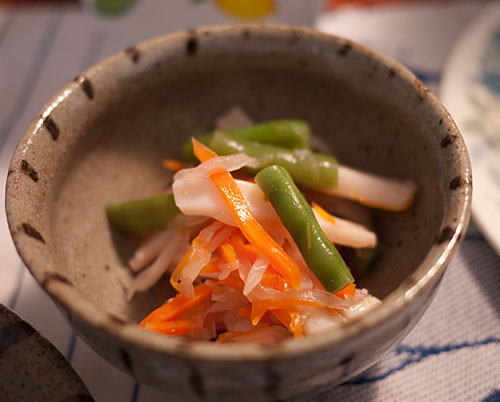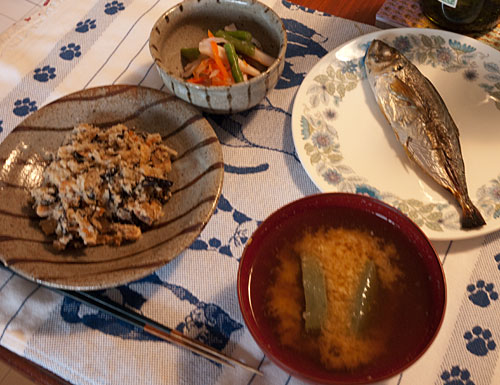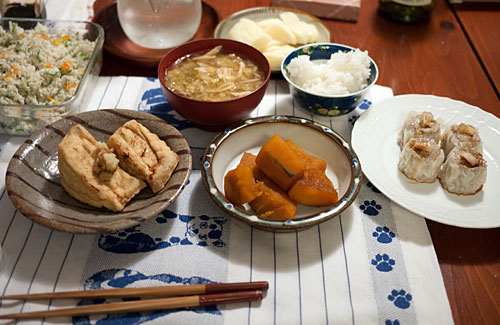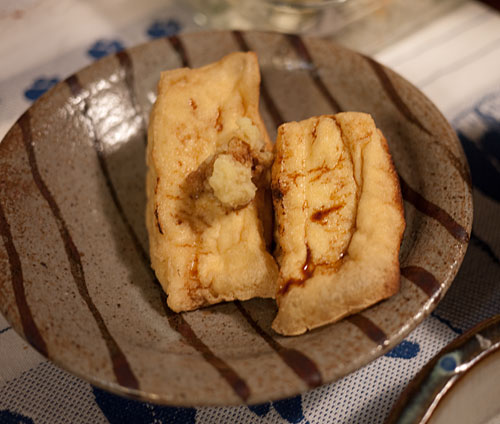Squid and vegetable ohitashi, plus some Japanese home meals

This is a very simple, low-calorie yet really tasty side dish from my mother. It's usually served in small bowls or dishes as part of a Japanese meal (see below), but you could increase the amounts and serve it as a sort of salad. The squid and vegetables get a double-hit of umami, from the dashi stock and the poaching liquid made from the leftover bits of the squid.
The most important part of the process may be getting hold of fresh squid. If you can't get fresh squid, there really is no substitute here.
Recipe: Squid and vegetable ohitashi
8 to 10 servings as part of a Japanese meal
- 2 fresh squid (my mother recommends yari squid, which are soft when cooked)
- sea salt
- 1 small carrot
- a small handful of bean sprouts
- a small piece (about 1 inch / 2cm long) of daikon radish
- a handful of green beans (10-12 green beans)
- 1 1/2 cups (360ml) dashi stock (or water plus instant dashi stock granules)
- 1 tsp. soy sauce
Peel and cut the carrot and daikon radish into thin strips. Cut the tops and tails off the bean sprouts. Cut the green beans into short pieces.
Gut and clean the squid. There's a pretty good how-to video here, although I do it even more simply by pulling on the whole head until the innards just slip out. Work over a bowl, so you catch all the liquid that comes out of the squid. Get rid of the ink sac, but otherwise keep all the guts and legs and stuff in that bowl. Take out the body itself, skin it, and cut it in half so you end up with two flat pieces. Cut that into strips about 3/4 cm / 1/4 inch wide, and sprinkle with sea salt and massage lightly with your hands.
Bring around 2 to 3 cups of water to a boil. Add the squid innards, legs and liquid that you saved in a bowl. Bring down the heat and simmer for a few minutes, then strain off the liquid into a clean pan through a fine mesh sieve. Bring the strained liquid up to a simmer.
Put the cut up and salted squid into the the simmering liquid, Simmer for about 2 minutes, then take the squid out and let cool. Put the carrots into the liquid, then the daikon radish and beans a couple of minutes later. Cook for 4-5 minutes until crisp-tender and add the bean sprouts at the last minute. Drain and cool.
Put the dashi stock in a bowl, and add the cooked squid and vegetables. Add the soy sauce and mix well. Cover, and leave to marinate in the refrigerator for at least an hour.
To serve, lightly drain off the marinating liquid and put into small bowls or plates. This keeps in the refrigerator for 3 to 4 days.
Variation: Add a tablespoon of rice vinegar to the marinade. Use snow peas (mangetout) instead of the green beans.
Lunch and dinner at my mom's
I arrived in Japan yesterday, and will be here for a few weeks. I'm often asked what a typical Japanese home meal looks like, so while I'm here I'll periodically post photos of what we have here at my mom's. Keep in mind that this household consists of my mother and stepfather only, both of whom are in their 60s. Households with kids or teenagers will eat a bit differently (when I go to my sister's place I'll see if I can sneak a few pictures of their meals too).
Note that both meals follow the typical Japanese meal construct of having rice as the main carbohydrate, with a soup, and at least two other dishes. See the anatomy of a Japanese meal.
This was the 'simple lunch' we had yesterday. (I apologize for the slightly blurry photo.) The centerpiece was a small bowl of shinmai or new-harvest rice - absolutely delicious! Plus, okara cooked with carrot and hijiki seaweed, a small grilled aji (horse mackerel), miso soup with fu (soft wheat gluten), and the aforementioned squid and vegetable ohitashi.

This was dinner. Again, there's some of that delicious shinmai (new harvest rice), plus okara and crabmeat salad, some hot-and-sour soup that my mom made from a readymade mix with some added shredded cabbage; grilled atsuage or deep-fried tofu (see Looking at tofu) with grated ginger; simmered kabocha squash; and shumai dumplings. Blurred in the background is a plate of takuan pickles. My mother managed to make all this in about half an hour - but she explained that that's because she just had to steam the storebought shumai, put the atsuage under the grill, and toss in some cabbage into the soup. The salad was made in advance, so she just had to take some out of the fridge; The takuan pickles are also storebought, and kept in a container in the fridge - it lasts for some time, and makes a trip out to the dinner table almost every day.. The one thing she made from scratch was the kabocha squash. Needless to stay, both meals were so good.

The star of the meal for me was the grilled atsuage, which came from Kinki, the Kyoto tofu store that I wrote about previously. It tasted so fresh!

If you enjoyed this article, please consider becoming my patron via Patreon. ^_^

 Welcome to Just Hungry, where we serve authentic Japanese recipes and more! I'm
Welcome to Just Hungry, where we serve authentic Japanese recipes and more! I'm 














Comments
sarah L.
20 October, 2010 - 05:31
Permalink
Re: Squid and vegetable ohitashi, plus some Japanese home ...
Your killing me. it's been a year & a half since I was in Japan & besides the amazing people it's the food I miss the most. I live in a Canadian prairie city, and although there is passable sushi, there is very few other Japanese dishes available in restaurants. That all looks so good.
Emma
20 October, 2010 - 07:52
Permalink
Re: Squid and vegetable ohitashi, plus some Japanese home ...
This is certainly Japanese home cooking at its best. Thanks for sharing!
Vincci
26 October, 2010 - 18:41
Permalink
Re: Squid and vegetable ohitashi, plus some Japanese home ...
Yum. Thanks for sharing these photos with us - I can tell that your mom takes a lot of care when it comes to her cooking!
m
27 October, 2010 - 16:48
Permalink
Re: Squid and vegetable ohitashi, plus some Japanese home ...
this is making me miss my mother & her home-cooked food.
btw, maki - i was wondering if you could do something similar to this dish with jellyfish?
maki
28 October, 2010 - 01:58
Permalink
Re: Squid and vegetable ohitashi, plus some Japanese home ...
I've never eaten jellyfish so I don't know...it's not a commonly eaten food in Japan, though it's eaten in some areas, while squid is a common everyday food.
Yuki
4 November, 2010 - 08:41
Permalink
Re: Squid and vegetable ohitashi, plus some Japanese home ...
Hi,
I love this post, all the more because I have just found a great fresh squid supplier here in London. SO now I can make it myself!
Yuki
www.yukiskitchen.com
Paula Bauer
22 November, 2010 - 21:18
Permalink
Re: Squid and vegetable ohitashi, plus some Japanese home ...
Wow! Now this looks absolutely delicious! I'll have to give it a shot soon.. thx for sharing :-)